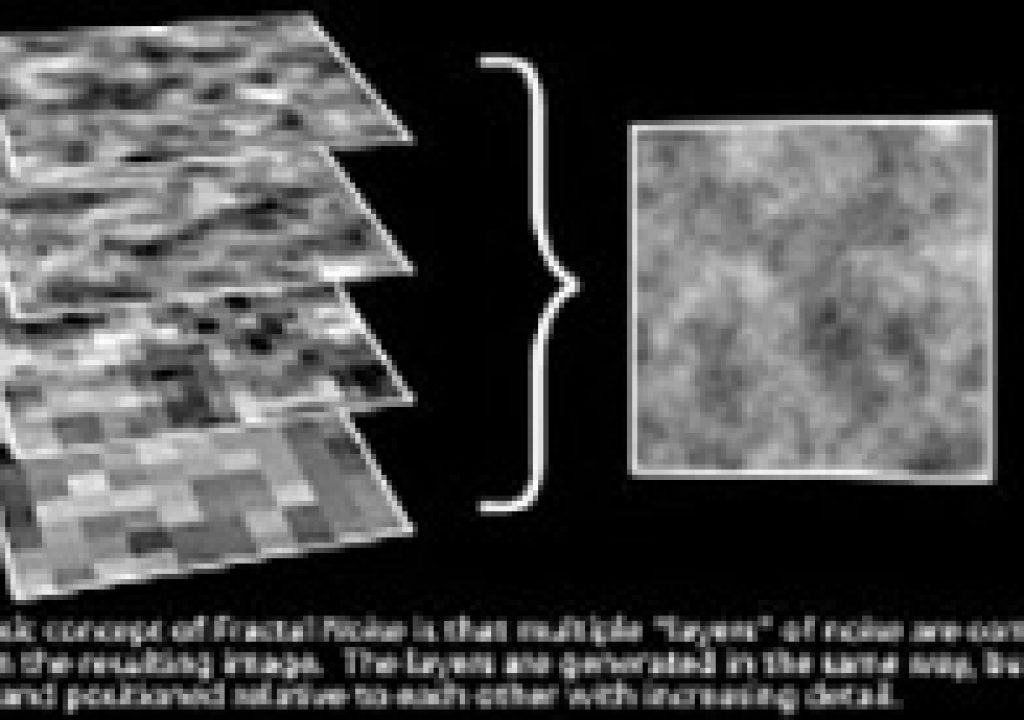The Fractal Noise effect built into After Effects has been used to displace or generate motion backgrounds, transitions, clouds, fog, fire, water, paper texture, metal and other textures, ink and watercolor effects, etc. There’s a good description of it, and some nice performance tips, in AE Help.
As a base to get your own creative juices flowing, the best single resource is from Chris Zwar, who clearly and deeply explains how the plug-in works in Fractal Noise – A New Look at an Old Friend (MIA?).
……………………………………………………………………………….
You might skip all this and check out the 2022 update of the classic article by Chris Zwar, Fractal Noise: Advanced analysis of After Effects most versatile plugin.
……………………………………………………………………………….
If you’ve never used Fractal Noise, you may want to look at The Very, Very Basics of Fractal Noise by Aharon Rabinowitz, at AE Help (especially for performance advice), as well as the useful Harry Frank video at bottom explaining fractal noise and how fractal noise is used in Trapcode 3D controls. Watch the video after the 6-minute mark to see Harry explain how Fractal Noise is created from Noise layers.
An alternative to this filter is the Turbulent Noise effect, an updated version of Fractal Noise that creates smoother animations, but doesn’t have Cycle controls to create seamless loops. One advantage of Turbulent Noise is that it is faster, being GPU-accelerated since CS4 (see After Effects: Experiment Assignment 7 at Motionworks for recent look experiments). Both effects are 32-bit per channel capable.
Here’s the basics from Aharon Rabinowitz and a 2022 Jake In Motion tutorial, Fractal Noise + Turbulent Noise | Effects of After Effects.
The use of Fractal Noise for fog was discussed by Mark Christiansen in Climate: Air, Water, Smoke, Clouds in After Effects 7.0, a free excerpt from the book After Effects Studio Techniques. To create a seamless loop of animation using Fractal Noise, see Christiansen or After Effects Help. For more on fog, see Pseudo-volumetric fractal clouds in After Effects and AEP archive posts tagged fog. Here’s another effective example, Realistic Fog Without 3rd Party Plug-ins, by Sachin man Joshi:
There’s even a script to create fractal noise in three dimensions, Fractal Noise 3D, which reacts to After Effects comp cameras and lights.
Chris and Trish Meyer have a meaty tutorial on techniques for using the After Effects filter Fractal Noise to create seamless background textures. Shortformvideo and Bob Donlon have several video tutorials, like Church Media Design in Looping Backgrounds: Fractal Effect. An earlier video by Aharon Rabinowitz also shows how to create seamlessly looping fractal background animations with AE’s Fractal Noise. Further, Dean Velez showed Fractal Noise Glowing Lines – how to use Fractal Noise to create flowing lines:
Harry Frank shares some secrets in his recent Fractal Noise Fade Effect video tutorial on a text transition in After Effects. He also used Fractal Noise in another tutorial, Text Effects with Set Matte. Here’s Fractal Noise Fade:
Here’s a few more resources among the many involving the built-in Fractal Noise effect:
- Angie Taylor published Creating Turbulent Noise, from the series Kinetic Typography Techniques with After Effects, which shows how to make an old film effect.
- Bran Dougherty-Johnson shared Muted Color Grading And A Vintage Film Burn Using Fractal Noise.
- Chad Perkins had basic treatments in his various tutorials, beefier in his book on AE effects, using AE’s built-in Fractal Noise to create both fire and water effects.
- Video Copilot made 23. Moving 3D Lines on creating flowing light streams using a fractal noise.
- ChurchMediaDesign.tv posted some not dissimilar with CMD 80: Looping Backgrounds: Fractal Noise Effect
- Charles Yeager has a more recent example with Quick Tip: How to Create Dynamic Backgrounds With After Effects
- Qtab.net has basic tutorials on fractal noise in Arabic, Fire reveal paper and Smoke & Cloud.
- Andrew Kramer shared 32. 3D Ocean and added displacement & camera action.
- Ocean Water Effect presentation by Aharon Rabinowitz from AENY.
- Stu Mashwitz had a free solar Corona (the iris of the sun) .aep on his website.
- Evan Abrams posted a short primer on Fractal and Turbulent Noises, demonstrating only the latter.
- Jerzy Drozda showed you how to a skydome and create a starfield using Fractal Noise, and more (embedded below).
Andrew Kramer tutorials are listed above, but he uses Fractal Noise as a building block for stuff like energy weapons discharge effects too, perhaps starting with Freaky Fractals. There’s Electric Energy, Seamless Spherical Maps!, Shockwaves in After Effects!, Sci-Fi Weapon FX!, etc. BTW, Freddie Wong made some fun light weapons too. We’ll sample a different one from Andrew, Solar Atmosphere!:
Many Trapcode products rely on fractal noise too. For example, “Turbulence in Trapcode Particular is a 4D displacement Perlin noise fractal (it is not based on fluid dynamics). It adds motion to particles in a way so that particles that are close to each other get a similar, but not equal, random motion. This helps tremendously when creating fire and smoke effects to make particle motion look natural and, unlike fluid dynamics, it computes fast and can be freely scrubbed back and forth in the timeline.”
Perlin Noise Fractal Theory was introduced in Trapcode Help > Physics > Air, and explained by Harry Franks in 03. Getting Started with Trapcode Particular 2 – Physics: Air. Yet more info on noise can be found in the Fractal Field group section of Trapcode Form’s help and in help for Trapcode Mir, where fractal noise is used to displace a 3D mesh. Here’s a nice comparison of AE Noise effect layers and fractal noise, and how it’s implemented in Trapcode Form, in Getting Started w/ Trapcode Form: Intro by Harry Frank.
~~~~~~~~~~~~~~~~~~~~~~~~~~~~~~~~~~~
Please note that this roundup is for quick review and comparison. There is almost always vital information from the originating authors at the links provided — and often free presets, plug-ins, or stock footage too.
Twitter: @aerich

